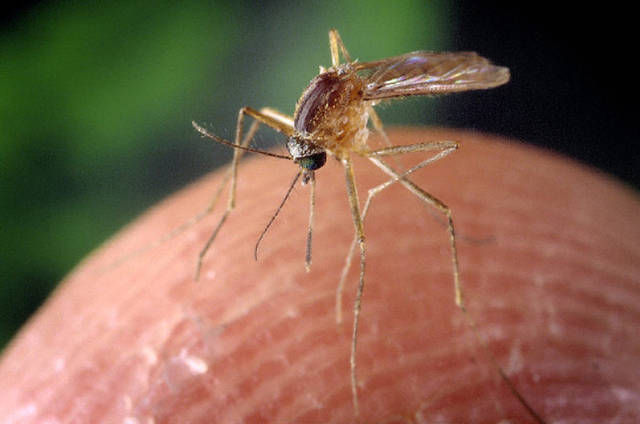West Nile cases at a minimum but mosquitoes still a threat ...

A Culex quinquefasciatus mosquito rests on a person’s finger. The Culex quinquefasciatus is proven to be associated with the transmission of the West Nile virus. COURTESY/U.S. Centers for Disease Control and Prevention
Oklahoma has only two confirmed cases of West Nile Virus so far this year, a low the state hasn’t seen since 2010-11, but health officials caution that mosquito season is far from over and that a wet August could still result in fertile breeding conditions for the bugs in weeks to come.
Following up on a resident’s complaint about lots of mosquitoes in her yard last week, Scott Meador found a prime example to post on the Tulsa Health Department’s Facebook page.
The vector control specialist found lots of little mosquito nests in the yard in question.

Tulsa World journalism makes a difference. Be part of the story. Join us. Start a digital subscription for only 99¢.
“The one on Facebook is just a little Styrofoam cup with a little bit of water in it,†he said. “That’s all it takes, and it was loaded with mosquito larvae.â€
The homeowner had positioned the cups around the yard in strategic spots to catch rainwater for watering plants, he said. But only small amounts of rain had fallen, and the bit of stagnant warm water in the cups proved fertile for mosquitoes.
The Culex species of mosquito is the common carrier of West Nile, and it thrives in hot weather and shallow stagnant waters.
Aedes mo squitoes, the busy biters often called “nuisance†mosquitoes, can still transmit the disease but are less commonly a vector, Meador said.
On a broader scale across Oklahoma, it appears that regular rainfall helped the mosquitoes through August.
“It’s actually the drought years that are the worst for the Culex mosquito,†said Tony Sellars, director of communications for the Oklahoma Department of Health.
But “with the exception of a few areas around town, the rain has regularly recharged things, so there actually has been less stagnant water,†Meador said. “At one point, west Tulsa got a ton of rain, where east side didn’t get much at all, and that was reflected in (the number of mosquitoes) captured in those areas, as well.â€
All it takes is the right place and conditions and some warm water â€" even if it’s just in a Styrofoam cup, he said.
Mosquito eggs can hatch into larvae in 24 to 48 hours, and it takes 10 to 14 days for them t o become mosquitoes. That’s why health agencies encourage people to clean out or empty any outside containers, including birdbaths and kiddie pools, at least once a week.
The two West Nile cases so far this year were in Oklahoma and Kay counties, Meador said.
Mosquito collections in Tulsa County have been relatively steady for most of the summer at around 1,000 to 1,500 a week, with only one or two traps showing positive as vectors for West Nile each week, according to Tulsa Health Department data. Only one week showed three positive results. That information was posted July 26. The report posted Friday showed one positive for 1,337 mosquitoes tested.
“I’ve actually been shocked by the numbers caught this year,†Meador said. “It seems to be way too low given the conditions, and we’re working hard to catch them. Maybe they’re really just not there this year, but it seems strange.â€
Oklahoma saw only one case of West Nile in both 2010 and 2011, but the following year was the worst on record, with 161 cases and 15 deaths in 2012.
The relatively low numbers this year don’t mean people should let down their guard, as the mosquito season runs well into October and November, depending on the year, Meador said.
“West Nile is here to stay,†Meador said. “Annually, it is weather dependent, and all you need are the right conditions for it to kick into high gear.â€
People planning outdoors activities are encouraged to use mosquito repellents and to wear clothing treated with Permethrin, wear pants instead of shorts and wear long-sleeve shirts too thick for a mosquito to bite through to avoid risk of disease transmitted by mosquitoes or by ticks.
Staff Writer Kelly Bostian
Kelly Bostian writes about and photographs all things involving the environment, conservation, wildlife, and outdoors recreation. Phone: 918-581-8357
Follow Staff Writer Kelly Bostian Your notification has been saved. There was a problem saving your notification.Whenever Staff Writer Kelly Bostian posts new content, you'll get an email delivered to your inbox with a link.
Email notifications are only sent once a day, and only if there are new matching items.
Follow Staff Writer Kelly Bostian Don't have an account? Sign Up TodaySource: Google News US Health | Netizen 24 United States





No comments